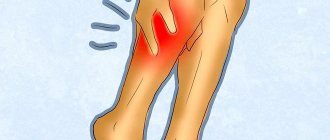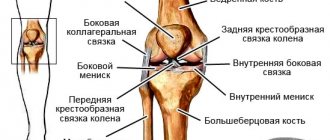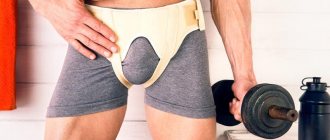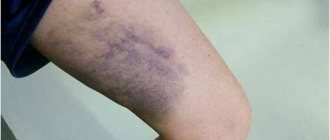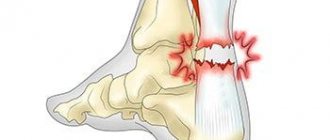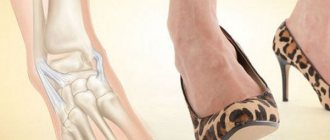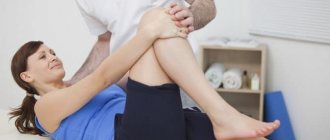Most people walk, run, tiptoe, jump and squat purely automatically and don't think twice about what allows them to do it easily, freely and almost effortlessly. Until a rather unpleasant and rather painful injury occurs - a twisted calf muscle.
You will have to forget about running, you will not be able to stand on your toes and you will only walk with a severe limp and with pain running through the entire leg. Sometimes it is not even clear how this happened. At one point, almost suddenly, my calf started to hurt and it wasn’t going to subside. Even stepping on this leg is problematic, and then the question naturally arises: what is a sprained calf muscle, what to do and, of course, how to treat it?
Factors and causes of sprains
Despite the case described in the previous paragraph, which anyone can confirm, the calf muscle itself cannot be damaged. It is quite flexible and contracts and expands very quickly. Therefore, it is impossible to get such an injury while lying on the couch or walking for recreational purposes. But as soon as a person starts exercising, goes on a hike, or simply rushes toward a bus that simply closes the door, the risk of twisting increases overnight. There are four main causes of calf injuries.
- Excessive stress on the calf ligaments. Simply put, the muscle was forced to stretch beyond its capacity.
- Rapid contraction of the calf muscle. Reverse movement. Muscle fibers cannot withstand contraction.
- Monotonous, prolonged efforts leading to muscle fatigue, which leads to decreased flexibility and injury.
- Physical external influence. A simple hit to the calf muscle can lead not only to dislocation, but also to rupture of the ligament.
After carefully studying all four points, it is safe to say that playing sports, exercising outdoors, or simply unexpectedly sudden movements can lead to injury to the calf muscle. This does not mean that tomorrow you will no longer have to go to the stadium or gym and forget about long walks in nature with a backpack on your shoulders. Absolutely not. All you have to do is start each workout by warming up all muscle groups, not just the calves, and you'll plan your hiking route to minimize falls, jumps and other extreme events.
1.Types of muscles
All muscles of the human body are divided into three groups: skeletal, smooth and cardiac. Only skeletal muscles are at risk of being stretched, since only they contract consciously. The other two groups are responsible for the work of internal organs and contract unconsciously, so the load on them is always proportionate to what is natural and physiological.
The muscles that support the skeleton and are responsible for our movements work at the will of our thoughts, and it is not always possible to calculate a safe load. In everyday life we sometimes set ourselves impossible tasks, in sports we strive for high results, in critical situations we make sudden movements that go beyond the resources and training provided by nature.
A must read! Help with treatment and hospitalization!
Symptoms of a sprain
The symptom of mild twisting can easily be described by a beginning athlete. This is called "auxiliary pain" and almost always occurs after the first workout. The pain is not severe, aching and intensifies with movement or tension of the injured muscle. This is caused by microcracks in the muscle fibers, which grow back quite quickly.
In the case of a severe sprain, the injured person feels as if he or she was kicked in the calf. If you do not immediately stop straining the muscles, the injury will worsen and it will become impossible not only to walk on tiptoe, but also to bend and abduct the foot.
If we hear an unpleasant characteristic click or a single click, and contractility subsides, the fracture is so serious that it requires quite a long treatment.
Any bruising or swelling that occurs means you need to immobilize your leg and go to the emergency room immediately.
First aid for sprains, treatment at home
Sprains of the lower leg muscles, as well as ligament ruptures, are within the competence of traumatologists; therefore, in order to avoid possible negative consequences, the victim should be shown to a specialized specialist.
On an outpatient basis, treatment is permitted if there are signs of sprain:
- maintaining motor functions of the leg;
- moderate severity of pain.
The ankle should not be overloaded. After receiving an injury, he must be kept at rest for at least 48 hours, secured with an elastic bandage and placed in an elevated position. If necessary, crutches can be used for mobility purposes.
In order to relieve swelling, dry ice should be applied to the injured area (in a bag wrapped in cloth) for 2 days for 20 minutes every 4 hours. On day 3 you should refrain from using compresses. From day 4, switch to warm compresses and baths (to stimulate resorption).
Optionally, on the recommendation of a doctor, you can use NSAIDs (non-steroidal anti-inflammatory drugs - Diclofenac, Ibuprofen), including in the form of ointments (Traumel, Apizartron, Voltaren emulgel, Viprosal, Ketonal gel).
© Africa Studio - stock.adobe.com
Types and degrees of stretching
The types of turns were described in the previous chapter, but the degree of difficulty is a topic for another discussion.
- 1st degree. These are micro-fractures. Virtually no treatment is required. It is recommended to reduce the intensity of training and other stress for 1-2 days.
- 2nd degree. Partial rupture of muscle fibers. Treatment is similar, but is not limited to 1-2 days.
- 3rd degree. A complete tear of the muscles and tendons requiring surgery may take six months to fully recover.
Diagnostics
An external examination of a patient with muscle fiber rupture is not very informative due to the similarity of symptoms of almost all ankle injuries. Differential diagnosis is carried out to exclude a fracture of the tubular bone, dislocation or damage to the Achilles tendon. What diagnostic tests can be performed:
- radiography. An X-ray examination reveals fractures and cracks in the bones;
- MRI or CT. The study is informative for establishing damage to any connective tissue structures: muscles, ligaments, tendons, soft tissues.
Diagnostics is also necessary to identify the inflammatory process that occurs during injury, the degree of its intensity and localization. The victim is also shown general blood and urine tests, the results of which make it possible to assess the general state of health.
First aid
If you clearly feel the characteristic pain and realize that you have strained the calf muscle, first of all, stop putting weight on the injured leg. It is recommended to apply ice or a bottle of cold water to the injured muscle. This will prevent bruising and reduce the likelihood of intramuscular hemorrhage. Wrap your calves tightly, but loosely, with an elastic bandage to prevent swelling.
If a third degree injury is suspected, immobilize the leg in a bent position and seek immediate help. to the doctor.
Surgical intervention
Treatment for a sprained calf muscle, which is characterized by rupture of most of the fibers, is only surgical. If the victim is taken to the hospital in a timely manner (within 1-3 days), the surgeon stitches the torn muscle and immobilizes the leg with a plaster cast for 2-3 weeks. After a course of rehabilitation measures, the functionality of the foot is completely restored after 1-3 months.
When a victim underestimates the severity of his condition and does not go to the emergency room, this causes shortening of the calf muscle, a decrease in its volume, and the development of degenerative processes in nearby connective tissue structures. A person is still forced to seek medical help due to the impossibility of full movement. Since muscle retraction has already occurred, its plastic restoration is necessary during arthroscopic surgery. The surgeon builds muscle tissue using a graft.
Healing procedures
In this section, you should omit the surgery and syndrome examples from the first exercise. In the first case, treatment takes place in a hospital, where the medical staff knows what to do and when to do it, and does not need outside advice. And in the second case, no treatment is required, only relative calm for the damaged muscle.
However, if you decide to treat yourself at home after a moderate sprain, you should follow these rules:
- In the first two days, it is necessary to provide the injured leg with proper rest.
- You can reduce the pain by taking painkillers. In this case, caution should be exercised, and in case of severe swelling, ibuprofen and aspirin, which thin the blood, should be avoided.
- To reduce blood pressure on the injured muscle, you should keep your leg slightly above the level of your heart.
- Every 5 hours, apply a cold compress for 15-20 minutes.
- At night, apply a cooling gel or ointment to the injured area.
- After 5-7 days, you can rub in warming ointments twice a day.
- At the same time, you should start doing light warm-ups and massage.
- It is also worth undergoing physiotherapeutic procedures in accordance with the doctor’s recommendations.
[wpmfc_cab_si] Treatment at home, as you can see, is not difficult, but before this treatment you need to go to the doctor and listen to his recommendations. [/wpmfc_cab_si].
Rehabilitation period
To restore the active functioning of muscles, the doctor draws up a set of rehabilitation measures. Following all recommendations will significantly speed up recovery. For mild sprains, rehabilitation begins after 2-3 days, at the stage of using warming ointments. In case of serious injury, recovery begins after removal of the plaster cast. What rehabilitation doctors recommend:
- massage, classic or acupressure, to improve blood circulation and microcirculation;
- 5-10 sessions of physiotherapy: laser therapy, magnetic therapy, UHF therapy, increasing the rate of muscle fiber regeneration;
- therapeutic exercises and physical education to restore all functions of the torn muscle.
From the very beginning of treatment, patients are shown electrophoresis with analgesics, NSAIDs, and calcium solutions to reduce pain intensity. If a sprain is combined with injury to a joint or bone, then chondroprotectors are used during physiotherapy.
Traumatologists recommend going to a hospital even with mild pain in the ankle. The victim cannot independently assess the severity of the sprain or identify concomitant injuries to the bones or ligamentous-tendon apparatus. Lack of treatment will cause the injury to worsen and serious complications to develop.
Informative video about ways to recover from injury:
Prevention
No one is immune from accidental falls, careless sprains and unexpected shocks, especially people who lead an active lifestyle, play sports and enjoy spending time in nature. However, this does not mean that calf muscle dislocation is in any way guaranteed. Elementary prevention methods can reduce this risk to a minimum. Any athlete will tell you that you should never max out muscles that aren't warming up. Therefore, before each active activity you should do a warm-up. In general, no one canceled daily morning exercises. Not only will it warm up all your muscles, but it will also open up your lungs after sleep and speed up blood flow. It will also lift your mood throughout the day, which is an important part of your success.
Signs of ligament damage or tear
There are several obvious symptoms of this type of injury that indicate the severity of the damage in the area. The most common include the following:
- Like any injury, a ligament rupture is accompanied by severe pain at the site of injury, usually the source of pain is the joint area. Therefore, an erroneous diagnosis is possible.
- Vessels are located next to and inside the ligaments, which can cause hematoma and edema to form. A ligament rupture itself is never open, but it can become part of a more complex complex injury.
- Since the ligament is the main stabilizing part of the joint, when it ruptures, the joint becomes unstable and pathological movements begin to occur in it, which should not occur normally.
- Given the damage or rupture of the ligaments, the joint may become deformed and its function may be impaired.
- There may be audible signs of ligament rupture in the form of a click, crunch or crack in the damaged joint at the time of injury.
In some cases, other symptoms are possible, including, first of all, increased body temperature and hyperemia. When a specific ligament ruptures, it is possible to experience special symptoms that are characteristic only of an injury in that particular location.
Rehabilitation for lower leg injuries
Recovery time is determined by the severity of the alteration and usually takes from 1 week to 2 months. Rehabilitation tactics are developed by the attending physician in consultation with the physiotherapist and exercise therapy instructor.
Use:
- local massage of damaged muscles;
- magnetic therapy, diadynamic therapy, ultrasound, laser therapy;
- taping – applying an elastic bandage to the back surface of the lower leg to prevent muscle tissue strain;
- physical therapy:
- walking;
- lifting the sore leg onto the toe.
Depending on the severity, rehabilitation begins from 2 to 7 days after the injury.
Returning to full training is possible only in the complete absence of myalgia and discomfort.
Folk remedies
At home, you can apply an ointment based on yolk. The composition includes one spoon of laundry soap, two spoons of water and one yolk. The resulting suspension is wrapped in gauze and applied to the site of injury. The compress is secured with a bandage. It is recommended to do it daily. The desired application time is no more than an hour.
Among the medicinal plants that help:
- plantain leaves;
- elderberry juice;
- eucalyptus oil;
- aloe leaf pulp.
Ethanol, vodka, clay or puff pastry are used as warming compresses. To prepare clay lotions, 100 g of powdered substance is mixed with 5 tablespoons of apple cider vinegar and diluted with water until a homogeneous suspension is obtained. The resulting composition is applied to the damaged area and covered with a cloth. The duration of the lotion is about an hour.
Preventive recommendations
To avoid repeated sprains, you can apply tapes.
It is impossible to insure against injuries, however, if you follow the recommendations of traumatologists, you can reduce the risk of getting them :
- do a warm-up warm-up before training;
- avoid physical inactivity, engage in sports with moderate physical activity;
- Wear comfortable, properly sized shoes for sports and everyday wear.
A calf muscle strain causes severe pain and discomfort to the victim. After an injury, it is necessary to limit the mobility of the injured limb and apply a cold compress to the problem area. Even if your leg is slightly injured, you should consult a specialist and follow his recommendations.

